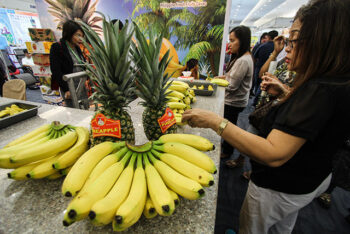Although the demand for the products had been increasing, supply of woven abaca is going down, she said.
Her business, which started as a home-based cottage industry in the late 1980's, is losing around P100,000 sales a month because of the supply problem, Valdez said.
"I have to turn down some of the orders because I don't want to commit when I cannot deliver because I know the supply can't catch up," she said. The Department of Education in Bukidnon, for instance, ordered around 1,800 conference kits made of abaca but "I only accepted 800 pieces.”
Valdez told MindaNews Monday that Lumad producers “always harvest abaca, but they don't plant new ones.”
Valdez, who owns at least two hectares of land planted to abaca, said a kind of plant disease has been ailing the city's abaca industry.
She said they are beginning to train their eyes on other crafts such as those made of rattan.
Valdez said another effect of scarce abaca supply is that they begin to produce products that are not purely made from abaca. She showed a bag made mostly of woven abaca fiber mixed with polyester-canvas cloth. She said the idea is not to sacrifice quality but to make do with available supply.
She said the situation merits closer government attention, especially in helping the local producers replace abaca plants with disease-free seedlings.
Valdez says indigenous products sell well in local tourism, conventions and exports.
Most of the city's backyard abaca plantations are in indigenous communities along the Bukidnon – Agusan del Sur border. She said she couldn't pinpoint who among the IP's are most aggressive in weaving abaca fiber into "hinabol" (the material used in Bukidnon's kamuyot backpacks).
In the past, she recalls, she would go to the Lumad communities to buy the product but as the trading picked up, the suppliers brought their goods to the "town proper."
Now that the supply has become scarce, Valdez is visiting the communities again or offering a higher buying price per meter for the woven hemp.
She said there are organized women among Umayamnon and Higaonon women in upland “but the government should see to it they are backed with support systems.”
Valdez said local traders are also losing the remaining suppl to traders from Cagayan de Oro and other cities in the country. She said they regularly go to the communities and buy the products there along with rice and other food items to entice the producers not to sell downtown.
In January this year, "hinabol" sold for at least P30 per meter. By mid-year, Valdez said they had to offer at least P5 to P10 more, per meter.
Today, the P65 a meter woven hemp here could sell for P100 to P150 per meter in the other cities.
She said Lumad producers should ride on the increasing demand for their products.
Valdez said there is a need to discuss with the Lumads the potentials of the industry. "The government could provide new seedlings, either on loan or grant. But the communities need trainings and other support mechanisms, too" she said. (Walter I. Balane/MindaNews)







